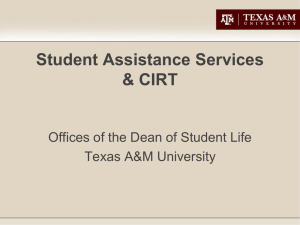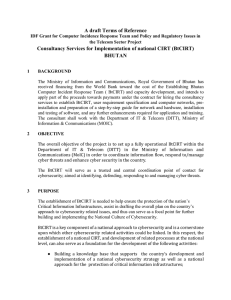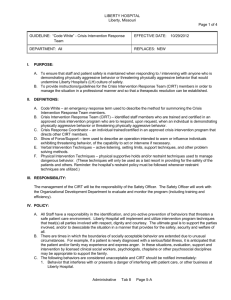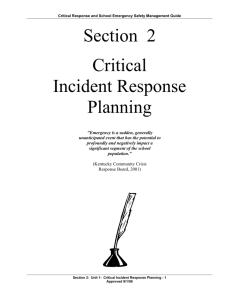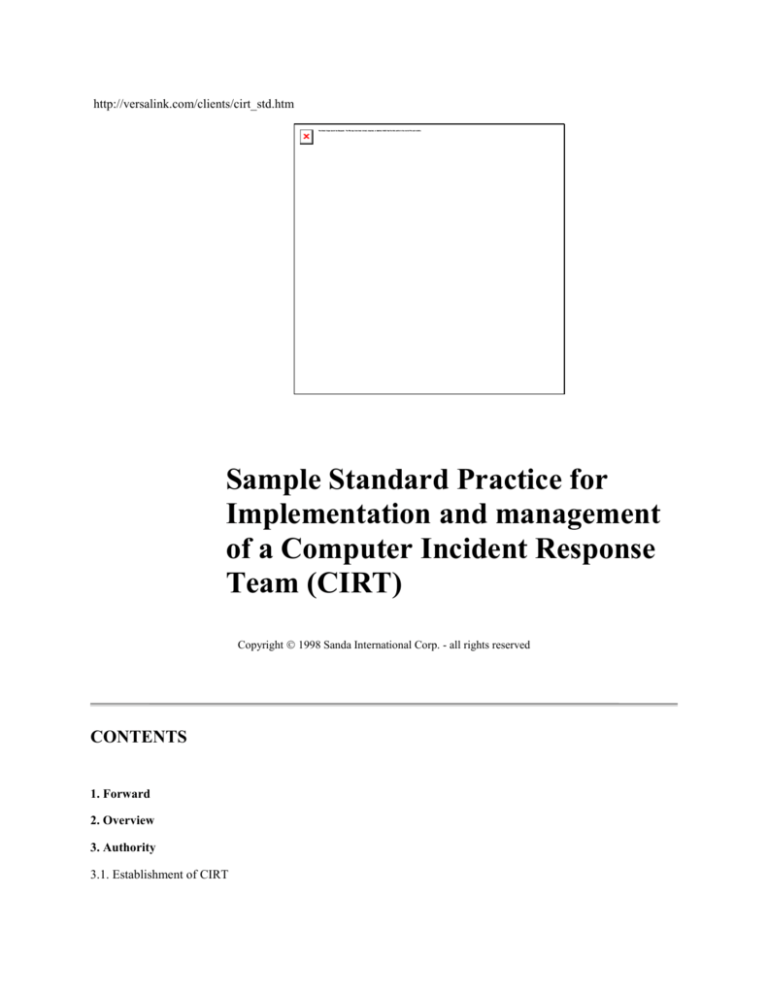
http://versalink.com/clients/cirt_std.htm
Sample Standard Practice for
Implementation and management
of a Computer Incident Response
Team (CIRT)
Copyright 1998 Sanda International Corp. - all rights reserved
CONTENTS
1. Forward
2. Overview
3. Authority
3.1. Establishment of CIRT
3.2. Mission
4. Description
4.1. Role of CIRT
4.2. CIRT Ownership
4.2.1. Duties of CIRT Owner
4.3. Responsibilities of CIRT
4.4. Availability of CIRT
5. Composition
5.1. Members
5.1.1. Core Members
5.1.1.1. IT Audit
5.1.1.1.1. Responsibilities
5.1.1.2. Information security
5.1.1.2.1. Responsibilities
5.1.1.3. Corporate security
5.1.1.3.1. Responsibilities
5.1.1.4. Legal
5.1.1.4.1. Responsibilities
5.1.2. Support Members
5.1.2.1. Platform specialists
5.1.2.1.1. Responsibilities
5.1.2.2. Financial auditors
5.1.2.2.1. Responsibilities
5.1.2.3. Fraud examiners
5.1.2.3.1. Responsibilities
5.1.2.4. Personnel Services
5.1.2.4.1. Responsibilities
5.1.2.5. Public information officer
5.1.2.5.1. Responsibilities
5.2. Team Leadership
5.2.1. Definition
5.2.2. Role
5.2.3. Requirements
5.2.4. Duties
6. Duties of the CIRT
7. Training requirements
7.1. Core member training
7.2. Support member training
7.3. Ongoing training
7.4. Periodic computer incident simulation drills
8. Computer security incident classifications
8.1. Identifying computer security incidents
8.1.1. CIRT notification process
8.1.2. Classification of severity of incidents
8.1.3. Escalation process
8.2. Class 1 incidents
8.3. Class 2 incidents
9. Investigative process
9.1. Methodologies
9.2. Investigative tool kit
9.3. Evidence collection
9.3.1. Evidence collection responsibilities matrix
9.3.2. Interviews
9.3.3. Physical evidence
9.4. Preserving evidence
9.4.1. Labeling
9.4.2. Transporting
9.4.3. Storage
9.4.4. Retention period
10. Report process
11. Investigation resolution
12. Relationship with law enforcement agencies
1. Forward
The Intrusion Management & Forensics Group is pleased to provide the sample standard practice for the
creation and maintenance of a Computer Incident Response Team (CIRT). This standard practice is meant
to be a starting point for your particular organization. The suggestions herein are only that: suggestions.
You should feel free to modify this standar practice such that it fits your circumstances, policies, personnel
and organizational culture.
This standard practice may be used freely and may be modified as necessary without permission from the
IMF Group. It may not, however, be redistributed in whole or in part outside of your organization without
crediting Sanda International Corp.. When distributed in whole, the Sanda International Corp. copyright
notice must be included.
Feel free to contact the IMF Group at info@imfgroup.com with questions and comments. The IMF Group
provides training to CIRTs through the Computer Security Institute. Visit their web site at www.gocsi.com
for more information.
2. Overview
Information Security Standard and Procedures defines the establishment of a Computer incident response
team (CIRT) to respond and manage any intrusion of The Company’s computer systems, networks or data
resources effectively.
The standards in this chapter are written under the authority and in support of the Company’s Information
Security policy. The standards apply to any suspected intrusion of The Company’s computer systems,
networks and data resources.
These standards will be updated annually or prior to a major infrastructure change. Nonetheless, due to
ongoing changes in the data processing and network environment, situations may occur where the
applicability of these standards may be unclear. It is the user's responsibility to seek a definition or
interpretation of the standards through Computer Technology Information Security.
Undefined or unclear standards cannot be construed to imply ignorance of a possible intrusion or reporting
obligation.
The standards apply to all persons who have access to The company's computer systems, networks and
Data Resources.
3. Authority
This standard practice is issued under the authority of the Chief Information officer.
1. Establishment of CIRT
The CIRT (Computer Incident Response Team) is a team of specialists established by the Chief
Information Officer to investigate any suspected intrusion into The Company’s computer systems,
networks, or data resources.
2. Mission
The objective of the CIRT is to investigate apparent intrusion attempts and report their findings in a timely
manner to executive management. The CIRT provides a centralized approach to managing computer
security incidents so that current incidents can be controlled as quickly as possible to avoid serious damage
to The Company’s systems and future incidents can be prevented. Additionally, the CIRT will provide
increased security awareness so that The Company’s computer systems will be better prepared and
protected in the future.
4. Description
1. Role of CIRT
The CIRT is an investigative body only, convened strictly for investigating an apparent
information security incident. The role of the CIRT is to respond rapidly to any suspected security
incident by reporting all findings to management, identifying and controlling the suspected
intrusion, and notifying users of proper procedures to preserve evidence and control the intrusion.
By being prepared to respond to serious incidents, the CIRT can minimize damage to The
Company’s computer systems, networks and data.
2. CIRT Ownership
The CIRT is owned by the Chief Information Officer (CIO). The CIO is responsible for all CIRT
activities and will ensure that the CIRT operates according to this standard practice as well as the
appropriate policies.
1. Duties of CIRT Owner
All decisions relating to incident resolution are the responsibility of the CIO who will make such
decisions after conferring with the General Manager and General Counsel. The CIO will institute
clean-up and "hardening" implementation when he or she deems it appropriate.
The CIO will alert affected external organizations which may share compromised or potentially
compromised resources with The Company. Such public investigative organizations as CERT,
FIRST and law enforcement will be contacted only under direction from the CIO. Should the CIO
decide to release details of an incident to a public investigative organization, the form of the
information release will be approved by the General Counsel.
3. Responsibilities of CIRT
Identify affected critical systems
Respond to all referred security incidents or suspected incidents involving The Company’s
computer system, networks and data resources.
Establish a 24 hour, 7 day a week hotline to report security incidents
Convene within 3 hours of notification of a reported computer security incident.
Establish classifications of security incidents requiring an investigation
Investigate and report all evidence to management
Asses damage and scope of intrusion
Control and contain intrusion
Collect and document all evidence relating to a computer security incident according to
established procedures.
Maintain a chain of custody of all evidence according to established procedures.
Notify users of correct procedures to ensure that evidence will be protected.
Notify users of any precautions to contain a security incident
Coordinate reposes to similar incidents or affected technology.
Select additional support members as necessary for the investigation
Follow privacy guidelines as established by The Company’s policy.
Provide liaisons to proper criminal and legal authorities.
4. Availability of CIRT
Security incidents can arise at any time of the day and on any day of the week. Often attacks happen during
non-business hours in the hope that the attack will go undiscovered until the damage has been completed.
In order to detect possible incidents and react swiftly to minimize damage to the Company’s computer
systems, networks and data, the CIRT must be available 24 hours a day and 7 days a week. A hotline for
reporting computer security incidents will be established by the CIRT.
Each core member must be on call to respond to hotline reports for a week’s duration. This on-call
responsibility will be rotated on a weekly basis among the core members of the CIRT.
On-call member’s responsibilities include:
Available by pager 24 hours a day, 7 days a week
Available to report in person to the affected system immediately after being notified.
Responsibilities of all other members of the core team and technical support team include:
Available to the on-call member by pager.
5. Composition
1. Members
Two types of members will comprise the CIRT team, core members and support members. The
Chief Information Officer will select the core members and appoint the team leader.
1. Core Members
The core members will convene when a security incident has occurred. They will be
responsible for:
Determining if the incident warrants further investigation
Categorizing the security incident
Adding support members to the investigation if necessary
1. IT Audit
A senior member of the IT Audit Services will be a core member a the CIRT.
1. Responsibilities
Ensure that best practices are followed
Ensure the auditability of the investigation process
Ensure that chain of custody procedures are followed correctly
Maintain accountability for all evidence collected during the investigation
Document investigation
2. Information security
A member of Information Security will be a core member of the CIRT.
1. Responsibilities
Inform all other users that are affected by the security incident of the necessary
actions to control the incident.
Perform appropriate backtracing, forensic analysis and other technical tasks
required by the investigation
Provide an analysis of the incident including root causes
Compile the final report and recommendations of the CIRT
Be available as an expert witness
3. Corporate security
1. Responsibilities
Provide a liaison with law enforcement
Ensure that investigative best practices are followed
Contain the incident locale as appropriate
Manage the interview process for witnesses and suspects
4. Legal
Counsel from the legal department will be a member of the core group.
1. Responsibilities
Brief other core and support members on privacy, 4th Amendment, search and seizure
and wiretap issues
Ensure that suspects’ rights are protected appropriately
Act as spokesperson with the media
Review any press releases before they are released to the media
Review any management reports
Act as liaison with outside legal counsel
2. Support Members
Support members will not be full time members of the CIRT team. These members have
valuable expertise in their fields. When an the core team determines that the investigation
requires the added expertise of a support member, that member will be added to the team
for the duration of the investigation.
1. Platform specialists
A platform specialist for each critical system will be a member of the support
team.
1. Responsibilities
Review audit logs and report any unusual or suspect activities
Report any unusual behaviors of the critical systems
Be prepared to brief the CIRT on operations procedures
Protect evidence of incident according to The Company’s guidelines and
instructions of the core team
Assess and report damage to system and/or data to CIRT
Aid in the determining the scope of the intrusion
Aid in identifying the point of access or the source of the intrusion
Make recommendations to close the source or point of access of the intrusion
2. Financial auditors
A member of financial auditing will be a member of the support team.
1. Responsibilities
Be prepared to brief the team on financial procedures
Be prepared to conduct a financial audit if the core team deems it necessary for
investigative reasons
Report findings to the CIRT
Follow investigative procedures as determined by the CIRT
3. Fraud examiners
Often a computer system will be used to commit fraud or will be the target for
fraud . When this situation occurs, a member of the fraud examiners will be
added to the investigation by the core team members.
1. Responsibilities
Aid the core members of the CIRT in discovery and recognition of fraud
Follow guidelines for lawful search
Follow The Company’s privacy policies
Aid in identifying objects and materials used to commit suspected fraud
Preserve, using CIRT guidelines, any evidence collected until transported to
CIRT
Transport evidence to CIRT for safekeeping until resolution of investigation
Report findings to the CIRT
4. Personnel Services
A representative who is well acquainted with personnel and human resource
policies will be a support member of the team.
1. Responsibilities
The support member from Personnel Services will be required to:
a)
Advise the core members on personnel policies and procedures
b)
Make recommendations for handling sensitive employee information
5. Public information officer
In the event that the intrusion has become public knowledge, the Public
Information officer will be added to the investigative team.
1. Responsibilities
a)
Act as a single point of contact for the media.
b)
Obtain legal advice before any interview or press release is given to the media
c)
Obtain approval from the CIRT that any interview or press release will not
with the investigation.
d)
interfere
Inform all other affected users to refer any media inquires to the Public
Information Officer.
2. Team Leadership
The Chief Information Officer will appoint one of the members of the core team to act as the
Team Leader. This role can be static or it can rotate through the team members at the CIO’s
discretion.
1. Definition
The Team Leader is responsible for convening the CIRT, managing team meetings and
directing the activities of the team. The Team Leader is the CIRT manager for the term of
his or her duties.
2. Role
The Team Leader fills the role of a group manager. As such he or she has management
responsibility for the activities of the CIRT and the authority to convene an investigation.
3. Requirements
The Team Leader must be a member of the core team. He or she must have received the
required training and must be appointed by the Chief Information Officer.
4. Duties
The Team Leader will perform the following duties
Convene the CIRT
Contact the Chief Information Officer
Conduct meetings of the CIRT
Periodically report status of investigations to the CIO
Manage investigations
Take responsibility for verifying chain of custody of evidence
Coordinate team activities
Appoint support members as required for particular investigations
Present findings to management
Monitor the investigation
Conduct a "post mortum" analysis of lessons learned and report to the CIO
6. Duties of the CIRT
The CIRT is an investigative body only. It does not make policy or take action following an investigation
except at the express instruction of the Chief Information Officer. The CIRT is a completely independent
body. It receives its direction from the Chief Information Officer, but is accountable directly to the General
Manager or the General Manager’s appointee.
In cases where an Incident may have originated from an employee or employees reporting, either directly
or indirectly, to the Chief Information Officer, the team will report a conflict of interest to the CIO and a
temporary alternative reporting structure will be implemented by the General Manager. In the event that a
similar conflict of interest involved a core team member, that conflict must be reported to the team and to
the Chief Information Officer immediately. The CIO will determine the appropriate course of action based
upon the circumstances surrounding the incident and the nature of the conflict of interest. In general the
CIRT’s duties include:
Determining if an event constitutes an investigatable security incident
Conducting an appropriate investigation to determine the root cause, source, nature, extent of damage and
recommended response to a computer security incident.
Preserving evidence of the incident
Interviewing witnesses and suspects
Providing appropriate liaison with law enforcement and outside legal counsel
Managing the release of information to the media
Managing interaction between Human Resources and witnesses, suspects, organized labor and other
appropriate interested parties
Preparing a report of findings, root causes, lessons learned and recommended actions for management
review
Carrying out the directions of management communicated through the Chief Information Officer
Containing the incident scene to prevent contamination of evidence
7. Training requirements
1. Core member training
Core members are required to obtain training in the following areas:
a)
Legal 4th amendment, privacy, and lawful search issues
b)
The Company’s policies and procedures
c)
Investigative process
d)
Storing and transporting evidence according to legal guidelines
e)
Vendor training on all current detection and investigative tools
f)
Collecting, preserving and analyzing evidence of a computer security incident
g)
Procedures for coordinating with outside organizations such as CERT, FIRST
enforcement
2. Support member training
Support members are required to obtain training in the following areas:
a)
Legal 4th amendment, privacy, and lawful search issues
b)
The Company’s policies and procedures
c)
Investigative process
d)
Storing and transporting evidence according to legal guidelines
and law
e)
Technical training on all platforms, operating systems and applications that
member
is responsible for. These platforms include, but are not limited to all
computer operating
systems and platforms currently in use The Company’s,
telephone PBX systems and
voicemail systems.
3. Ongoing training
Core team members will obtain periodic training to account for:
Updates in tools used in their investigations
Updates in investigative and forensic techniques
Updates in appropriate technologies
Updates and changes in laws, regulations and The Company’s policies that affect investigations
4. Periodic computer incident simulation drills
The CIRT will conduct incident simulation drills twice per year. These drills will be monitored by the
Chief Information Officer and the Manager of Internal Auditing. The purpose of these drills is to simulate
computer security incidents for the purpose of maintaining the appropriate skills of team members. All core
members will be required to participate and support team members will be selected to fulfill appropriate
roles. The drills will strive for realism, thoroughness and appropriateness. A "post mortum" will be held at
the completion of the drill to identify weaknesses in member performance and the appropriate training to
alleviate those weaknesses.
8. Computer security incident classifications
1. Identifying computer security incidents
A security incident is any event resulting in The Company’s computer systems, networks or data
being viewed, manipulated, damaged, destroyed, or made inaccessible by an unauthorized person.
1. CIRT notification process
All computer security incidents will be reported immediately to the The Company’s help
desk. The help desk operator will notify the CIRT member on call using the CIRT pager.
The CIRT member on call will analyze available information immediately and make a
determination as to whether the core team should be convened. If the on-call member
determines that the CIRT should convene, the core team will meet within three hours of
initial notification.
If it is, in the judgment of the on-call member, appropriate to isolate the incident scene,
he or she will notify corporate security through the team representative and that member
will arrange immediately to contain the site following appropriate processes. If a
technical platform specialist is required the on-call member will identify and contact that
individual immediately.
2. Classification of severity of incidents
There will be three classes of incidents: Class 1, Class 2 and Special. Class 1 incidents
are those which are localized, minor or do not require CIRT involvement. They are
investigated by the appropriate department manager. Examples of Class 1 incidents are:
Localized virus attacks
Internet abuse
Incidents traceable to user error or system failure
Minor attempts at intrusion, scanning or pinging
Class 2 incidents require CIRT involvement. These incidents are major incidents that put
the The Company’s information assets at risk. Examples of Class 2 incidents are:
Attacks against a firewall
Coordinated, distributed attacks
System-wide virus attack
Financial fraud involving computers
Attacks against a file server or host
Theft of proprietary information
Attacks against any sensitive system (HR, Legal, Financial, etc.)
It is the responsibility of the CIRT to classify suspected security incidents. However, the
CIRT or corporate management can escalate a Class 1 incident into a Class 2 incident if
appropriate.
Special incidents are those which are referred to the CIRT as a result of a request by a
department manager. Such requests must be approved by the Chief Information Officer.
Disposition of Special incidents will be determined by the Chief Information Officer in
consultation with the requester and the CIRT Team Leader.
3. Escalation process
An incident may be escalated from a Class 1 to a Class 2 incident in any of the following ways:
Decision of the CIRT Team Leader
Decision of the Chief Information Officer
Additional related events (i.e., emergence of a distributed, coordinated attack as an example)
Request by Executive Management
2. Class 1 incidents
Escalation from symptoms of an equipment failure or user error to a Class 1 incident may be
initiated by the responsible manager. Once the escalation occurs, however, the incident must be
reported to the CIRT team leader or the team member on call.
3. Class 2 incidents
Escalation from a Class 1 to a Class 2 incident may be initiated by the CIRT, the Chief Information Officer
or corporate management. The escalation and the reason for the escalation must be documented as part of
the investigation.
9. Investigative process
In all CIRT investigations a formal investigative process will be used. That process will be appropriate to
the incident, consistent with investigative best practices and thoroughly documented. All members of the
investigating team are expected to document their actions thoroughly, retain a copy of their notes for future
personal use (i.e., as an expert witness in resulting litigation or criminal proceeding) and submit a copy to
the team for use in preparing the final report. The member of the team from IT auditing will retain all
records, notes and reports for a period of 3 years after the incident.
1. Methodologies
The investigative team will use current best practices in their investigations. These practices are
intended to ensure the following:
Suspect’s rights are preserved to the extent dictated by current The Company’s policies
Evidence is properly collected, preserved and documented
Conclusions are supported fully by facts in evidence
A full and complete investigation is conducted, free from contamination by outside influence
Appropriate confidentiality is maintained
The incident is contained appropriately to protect The Company’s information assets from further
exposure
2. Investigative tool kit
Appropriate investigative tools will be assembled and maintained in a single location to support
rapid response to an incident. These tools will be appropriate to the current state of the art both
from the perspective of the tools themselves and the systems against which they are directed.
Physical security regarding these tools will be maintained at all times. In addition to on-site tools,
such as back-up devices, cameras and forensic software, a forensic laboratory consisting of a PC,
back-up/restore device and forensic software will be maintained and will be physically secure. The
team leader will review available investigative tools from time to time to ensure that the tool kit
contains state of the art hardware and software.
3. Evidence collection
1. Evidence collection responsibilities matrix
The team leader will establish an Evidence Collection Responsibilities Matrix. This
matrix will assign evidence collection duties to various team members consistent with
their profession and personal skills as well as with their functions on the CIRT.
2. Interviews
Interviews will be conducted in a professional manner using standard investigative
interviewing techniques. Interviews will be documented, usually immediately after the
interview. All confessions either will be recorded using video or audio, or will be hand
written and signed by the suspect. Written confessions must be witnessed. The
Company’s investigation procedures, as used by corporate security personnel, will be
followed in all interviews and interrogations. Where interviews are governed under labor
contracts, a member of Human Resources as well as the team member from the Legal
Department must be consulted to ensure compliance with contract provisions.
3. Physical evidence
Physical evidence must be collected and preserved using an appropriate chain of custody. A
lockable room, cabinet or locker will be provided for securing evidence. Custody of all keys, lock
combinations or electronic key cards will be accounted for. Only one person, the custodian of the
evidence, should have access to the room, cabinet or locker. All transfers of evidence must be
thoroughly documented and signed for. At no time should the custodian of the evidence be
unaware of its location or physical security. See "Storage" below.
4. Preserving evidence
Evidence must be protected and preserved once it has been seized. Improper handling, labeling,
and storage could destroy valuable evidence or make it unusable as evidence. All persons involved
in the chain of custody of evidence must follow these guidelines to protect and preserve evidence:
1. Labeling
The requirements for labeling collected evidence are:
a)
Each piece of evidence should be placed in a sealed envelope or evidence bag.
b)
A label containing your signature, date, complete description of contents and
identification number should be placed over the envelope seal to ensure that no one has
tampered with the contents.
c)
label.
Anyone who takes possession of the evidence, must sign and date the evidence
d)
Envelopes should be placed into a binder if possible.
e)
Label with tags all equipment and cables. Make sure that all cables and
connections are labeled to ensure that they can be reconnected in the proper order.
2. Transporting
Evidence being transported must continue to conform to chain of custody requirements.
At no time should evidence be out of the direct control of the custodian. When evidence,
such as computers, must be transported in such a manner that it is outside of the
custodian’s direct control, it must be sealed in packaging that will reveal any attempt at
tampering and transported by an agency that can attest to its specific location and
handling. Examples would be UPS, Federal Express or airlines counter-to-counter.
Signed acceptance (i.e., via signed airbill) must be obtained by the custodian and the
receiver (when delivered by the shipper) must take immediate, personal custody and
obtain a delivery signature from the delivery agent. U.S. mail is not an acceptable method
of transport in most cases.
3. Storage
The storage facility for computer evidence must be a friendly environment for electronic
equipment and media as well as a secured area.
The storage facility must be:
a)
Locked at all times
b)
All persons entering or leaving the locked area must be logged according to
time, date and identification by a core member of the CIRT
c)
Document all evidence entered or checked out of the storage facility
d)
Meet all temperature, light, and humidity requirements of all electronic media
4. Retention period
Civil litigation can take years to complete. Therefore, the retention period of evidence is tied to the ultimate
resolution of the incident. Litigation and criminal prosecution may be subject to appeal, extending the time
that evidence must be preserved. Therefore, some judgment must be exercised in the length of time
evidence must be retained.
In no case should evidence be disposed of before a case involving it is concluded including the appeal
process. Such evidence should then be retained for at least a year past the supposed conclusion of the entire
case including appeals. Where it is not apparent whether the incident will ultimately result in civil litigation
or criminal prosecution, evidence should be retained for a minimum of three years or, in the case of
possible criminal action, until the statute of limitations expires for the particular crime involved.
10.
Report process
The CIRT is responsible for reporting their findings to management at the conclusion of the investigation.
This report should include the following:
Executive summary - include a description of the incident, methods of investigation and general
conclusions.
Detailed conclusions - include one section for each conclusion drawn by the CIRT. This section describe
how the CIRT arrived at the conclusion, lists exculpatory evidence that may prove contradictory and
evidence that support the conclusion. Log entries can show a chain of events that support the CIRT’s
conclusion.
Recommendations - the report should conclude with the CIRT’s recommendations for avoidance of future
or repeat incidents.
11.
Investigation resolution
Ideally, an investigation concludes when an appropriate explanation of the incident is found, a final report
is delivered and management declares the case "closed". From a practical perspective, however, there are
events and circumstances which can terminate an investigation prematurely or extend its final resolution
beyond report production. Generally, the acceptance of a final report by management concludes the
investigation. However, the investigation may extend beyond that point when:
Litigation or criminal prosecution results
There are technical challenges to the conclusions of the CIRT
Management is dissatisfied with the conclusion
Assistance from the CIRT is required to implement preventive measures
The investigation may terminate prematurely when:
The Chief Information Officer terminates the investigation
In the CIRT’s considered opinion the incident cannot be solved
Management declares that the incident investigation should be terminated
The investigation passes to law enforcement
Legal action is brought by a party involved in the investigation to terminate it
The investigation, key evidence or critical information becomes contaminated rendering a reliable
conclusion impossible
12.
Relationship with law enforcement agencies
The CIRT will initiate and maintain a close relationship with appropriate law enforcement
agencies in advance of any information security incident. The intent of this relationship is to foster
an atmosphere of cooperation and encourage rapid response should law enforcement involvement
be required.
Additionally, the CIRT should become aware, through direct law enforcement contact, of the
standards and requirements for law enforcement involvement in the CIRT’s local community. The
CIRT’s relationship with law enforcement and the standards dictating a request by The Company
for involvement by law enforcement in a particular investigation are set forth both in the law and
in The Company’s policy. The CIRT member from the Legal Department will become thoroughly
familiar with all aspects of law enforcement involvement and will ensure that the team is briefed
fully on those aspects. It will be the responsibility of the member from Corporate Security to
maintain official liaison with the appropriate law enforcement agencies including, Federal, state,
county local and any computer crime task forces in the immediate area.
The member of the team from the Legal Department will become thoroughly familiar with the
various laws and statutes involving computer related crime and will ensure that the law
enforcement agencies with appropriate jurisdiction are contacted when required.
The Chief Information Officer will determine when and if law enforcement agencies should be
called during the course of the investigation. He or she will confer with the CIRT, the General
Manager and the General Counsel before contacting a law enforcement agency. Executive
management will determine, after the investigation is complete and the CIRT has reached a
resolution to the incident as declared by the CIO, what resultant action is to be taken.

